Broken Arm Overview
A broken or fractured arm means that one or more of the bones of the arm have been cracked. This is a common injury occurring in both children and adults. In adults, fractures of the arm account for nearly half of all broken bones. In children, fractures of the forearm are second only to broken collarbones.
The arm consists of 3 major bones. The humerus runs from the shoulder to the elbow. This is called the upper arm, or, simply, the arm. At the elbow, the humerus connects with 2 bones: the radius and the ulna. These bones go from the elbow to the wrist and are regarded as the forearm.
Broken Arm Causes
Almost all injuries to the arm that result in a broken bone are caused in 2 ways: falls and direct trauma.
- The typical fall that produces a fracture occurs when you fall on your outstretched hand. The location of the fracture can be from the wrist up to the shoulder depending on the direction of the fall, the age of the person, and other factors that modify the stresses applied to the bone.
- Direct trauma can be from a direct blow from an object such as a bat, the trauma during a car accident, or any accident that causes the direct application of force to a part of the arm.
Broken Arm Symptoms
Most broken arms have these symptoms:
- A large amount of pain and increased pain when moving the arm
- Swelling
- Maybe an obvious deformity compared to the other arm
- Possible open wound either from the bone puncturing the skin or from the skin being cut during the injury
- Decreased sensation or inability to move the limb, which may indicate nerve damage
When to Seek Medical Care
Call your doctor after an accident if these signs are present:
- Significant pain that is not relieved by ice and home pain medications such as acetaminophen (Tylenol) or ibuprofen (Motrin)
- A large amount of swelling or mild deformity of the arm compared to the opposite arm
- Significant pain with use or limited use of the affected arm
- Pain in one specific part of the arm when it is pressed
Your doctor may advise you to go directly to a hospital's emergency department. Under the following conditions, go directly to the hospital for emergency care:
- Visible bone sticking out through the skin
- Heavy bleeding from an open wound
- Complete lack of movement or sensation of part of the arm
- Obvious deformity that looks drastically different from the usual appearance
- Loss of consciousness
- Many other injuries
Exams and Tests
The initial evaluation by any physician, in the office or in the emergency department, begins with a thorough history and physical exam. By finding out the details of the accident, the doctor may be able to determine what damage was done based on the mechanism of the trauma.
After taking a history, the physician will do a complete physical exam with special focus on the painful areas. The doctor is looking for signs of a fracture (such as swelling or deformity) and checking for possible nerve or blood vessel damage.
X-rays are typically the test used to assess for broken bones. At least 2 views of the arm are taken. Initially, most broken bones will have an apparent fracture or other abnormality on the x-ray. Some fractures are not always visible on the first set of x-rays. In those instances, a CT scan or MRI may be done immediately for further evaluation, or follow-up x-rays may be obtained at a later date.
Broken Arm Treatment Self-Care at Home
- The most important aspect of first aid is to stabilize the arm. Do this by using a towel as a sling. Place it under the arm and then around the neck. An alternate approach to keep the arm from moving is to position a rolled and taped newspaper along the swollen area and to tape it in place.
- Apply ice to the injured area. This can help to decrease pain and swelling. Place ice in a bag and leave it on the arm for 20-30 minutes at a time. It may be helpful to place a towel around the ice bag or in between the bag and the skin to protect the skin from getting too cold. Never put ice directly on the skin.
Medical Treatment
The most important aspect of treating fractures is to determine which ones can be treated with outpatient care and which require admission to the hospital.
In most instances, the broken arm will be able to be treated in the emergency department.
- Most fractures will need to have a splint or partial cast applied to stabilize the broken bones. Some breaks especially in the upper arm and shoulder may only need to be immobilized in a sling.
- In addition to splinting the broken arm, the physician will prescribe medicines for pain control and ice to decrease swelling.
- Typically, wounds that warrant admission to the hospital are these:
- Bones that have gone through the skin or have lacerations over the broken area
- Fractures that are associated with nerve damage
- Fractures that are associated with blood vessel damage
- Complicated fractures that have multiple breaks, involve the joints, or are unable to be stabilized in the emergency department or doctor's office
Next Steps Follow-up
Most broken arms will not require admission to the hospital. For all other fractures, the treating doctor will suggest you follow up with an orthopedic doctor (bone specialist). At that time, the orthopedist will determine what further care (continued splinting, casting, or surgery) is necessary based on the type of fracture.
Additional follow-up instructions for fractures include the following:
- Wear any support device (splint, sling, or brace, for example) until the doctor sees you for follow-up.
- Keep your splint or cast clean and dry.
- Apply ice to the injured area for 20-30 minutes 4-5 times a day.
- Keep your arm elevated above the heart as much as possible to decrease swelling. Use pillows to prop your arm while in bed or sitting in a chair.
- Take pain medicine as prescribed. Do not drink or drive if you are taking narcotic pain medication.
- Call your doctor for increased pain, loss of sensation, or if your fingers or hand turn cold or blue.
Prevention
There are 2 main ways to help prevent a broken arm.
- Wear appropriate personal safety equipment as protection. Wearing car seat belts, using wrist guards for in-line skating and skateboarding, and wearing appropriate pads for contact sports are all good ways to prevent bone fractures.
- Prevent and treat osteoporosis, the disease that causes bone loss, especially in older women. These women tend to have more fractures as they age. In this group, the use of calcium supplements and estrogen replacement would help to reduce the number of fractures resulting from weakened bones. The best treatment for osteoporosis is prevention. This is best done early in life by building stronger bones through a good diet and exercise. Women of all ages should discuss techniques for prevention and treatment of ongoing osteoporosis with their doctor.
Outlook
The majority of fractures heal and normal arm movement is restored.
Many of these factors based on the individual injury and medical history may determine the final outcome of a broken bone:
- Earlier treatment usually improves results.
- Fractures in younger children and adolescents tend to heal better.
- Fractures that have multiple breaks, involve a joint, have open wounds, or become infected could have healing complications.
- Older adults have an increased chance of losing some ability or movement in the broken arm.
- Chronic diseases such as osteoporosis and diabetes may slow the healing process.
Multimedia
Media file 1: Fractured forearm of both bones (radius and ulna). Photos courtesy of Courtney Bethel, MD, and Anthony Dean, MD.
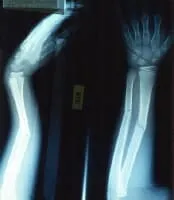
Media file 2: Forearm fracture with multiple fragments
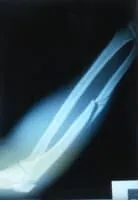
Media file 3: Upper arm fracture after casting
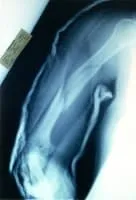
Media file 4: Forearm fracture (ulna) after splint application
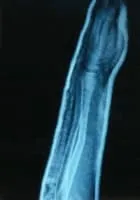
Media file 5: Broken shoulder (humerus)
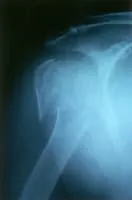
Media file 6: Fracture of the forearm in a child

Synonyms and Keywords
fractured arm, greenstick fracture, dislocation fracture, pathologic fracture, closed fracture, occult fracture, comminuted fracture, compound fracture, buckle fracture, Colles fracture, broken arm